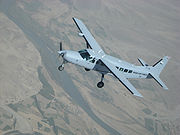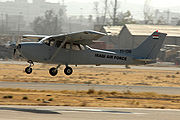| 52d Expeditionary Flying Training Squadron [1] | |
|---|---|
 52d Expeditionary Flying Training Squadron emblem | |
| Active |
1 February 1940 - 20 May 1946 1 July 1972 - 30 September 1977 11 May 1990 - 1 April 1997 29 March 2007 - Present |
| Country | United States |
| Branch | United States Air Force |
| Type | Pilot Training |
| Part of | 321st Air Expeditionary Training Group |
| Garrison/HQ | Speicher Air Base |
| Decorations |
|

An Iraqi Air Force T-6A lands at COB Speicher, Tikrit, Iraq.

An Iraqi Air Force Cessna 208 flies over Iraq on a training sortie.

An Iraqi Air Force Cessna 172 lands at Kirkuk Air Base.

52d Bombardment Squadron emblem
The 52d Expeditionary Flying Training Squadron (52 EFTS) is part of the Iraq Training and Advisory Mission - Air Force (ITAM-AF) and is based at Contingency Operating Base (COB) Speicher, Tikrit, Iraq. It operates T-6A aircraft conducting flight training for members of the Iraqi Air Force. C-172 and C-208 aircraft will be moved from Kirkuk Air Base to COB Speicher in spring 2010 to be incorporated in the flying training program.
Mission[]
Train, educate and advise professional Iraqi Airmen in order to build the institutional capacity to conduct credible fixed and rotary wing flight training for the Iraqi Air Force.
History[]
Activated in early 1940 as part of the pre-World War II build up of the United States Army Air Corps after the breakout of war in Europe. Assigned to the GHQ Northeast Air District, equipped with B-18 Bolos; later early model B-17C/D heavy bombers. After the Pearl Harbor Attack. flew antisubmarine patrol missions in the Caribbean from, January–June 1942.
Returned to the United States in June 1942 and was assigned to II Bomber Command. Was an Operational Training (OTU) and later Replacement Training Unit (RTU) for B-17 heavy bomber units and replacement personnel until March 1944 with the end of Heavy Bomber training.
B-29 Superfortress operations against Japan[]
Re-designated on 1 April 1944 as a B-29 Superfortress Very Heavy bombardment squadron. When training was completed moved to North Field Guam in the Mariana Islands of the Central Pacific Area in January 1945 and assigned to XXI Bomber Command, Twentieth Air Force. It's mission was the strategic bombardment of the Japanese Home Islands and the destruction of its war-making capability. Flew "shakedown" missions against Japanese targets on Moen Island, Truk, and other points in the Carolines and Marianas. The squadron began combat missions over Japan on 25 February 1945 with a firebombing mission over Northeast Tokyo. The squadron continued to participate in wide area firebombing attack, but the first ten day blitz resulting in the Army Air Forces running out of incendiary bombs. Until then the squadron flew conventional strategic bombing missions using high explosive bombs.
The squadron continued attacking urban areas with incendiary raids until the end of the war in August 1945, attacking major Japanese cities, causing massive destruction of urbanized areas. Also conducted raids against strategic objectives, bombing aircraft factories, chemical plants, oil refineries, and other targets in Japan. The squadron flew its last combat missions on 14 August when hostilities ended. Afterwards, its B 29s carried relief supplies to Allied prisoner of war camps in Japan and Manchuria Squadron remained in Western Pacific, although largely demobilized in the fall of 1945. Some aircraft scrapped on Tinian; others flown to storage depots in the United States. Remained as a paper unit assigned to Twentieth Air Force until inactivated in 1946.
Undergraduate Pilot Training[]
It conducted undergraduate pilot training from, 1972–1977 and 1990-1997. The 52d was reactivated in March 2007 as the first ever US Air Force expeditionary flying training squadron and the first flying training squadron activated in a combat zone. Its mission is to train, educate and advice Iraqi airmen to conduct undergraduate and instructor pilot training for the Iraqi Air Force.[1]
Operations and decorations[]
- Combat Operations: Antisubmarine patrols, Dec 1941-Jun 1942; Combat in Western Pacific, c.16 Feb-15 Aug 1945. Operation Iraqi Freedom; Began training the Iraqi air force for training its own flight crews, 2007–2012
- Campaigns: World War II: Antisubmarine, American Theater; Western Pacific; Air Offensive, Japan.
- Decorations: Distinguished Unit Citations: 31 Mar 1945; 19-26 Jun 1945. Air Force Outstanding Unit Awards: 1 Jan-31 Dec 1973; 1 Jan 1976-28 Feb 1977; 1 Oct 1995-[1 Apr] 1997.
Lineage[]
- Constituted 52d Bombardment Squadron (Heavy) on 22 Dec 1939
- Activated on 1 Feb 1940
- Redesignated 52d Bombardment Squadron, Very Heavy, on 28 Mar 1944
- Inactivated on 1 Apr 1944
- Activated on 1 Apr 1944
- Inactivated on 20 May 1946
- Redesignated 52d Flying Training Squadron on 22 Mar 1972
- Activated on 1 Jul 1972
- Inactivated on 30 Sep 1977
- Activated on 11 May 1990
- Inactivated on 1 Apr 1997
- Redesignated 52d Expeditionary Flying Training Squadron, and converted to provisional status, on 23 Mar 2007
- Activated on 29 Mar 2007.
Assignments[]
- 29th Bombardment Group, 1 Feb 1940-1 Apr 1944; 1 Apr 1944-20 May 1946
- 29th Flying Training Wing, 1 Jul 1972-30 Sep 1977
- 64th Flying Training Wing, 11 May 1990
- 64th Operations Group, 15 Dec 1991-1 Apr 1997
- 370th Air Expeditionary Advisory Group, 29 Mar 2007-1 Nov 2008
- 321st Air Expeditionary Advisory Group, 1 Nov 2008–Present
Stations[]
|
|
Aircraft[]
|
|
References[]
This article incorporates public domain material from the Air Force Historical Research Agency website http://www.afhra.af.mil/.
- Maurer, Maurer, ed (1982) [1969]. Combat Squadrons of the Air Force, World War II (reprint ed.). Washington, DC: Office of Air Force History. ISBN 0-405-12194-6. LCCN 70605402. OCLC 72556. http://www.airforcehistory.hq.af.mil/Publications/fulltext/combat_sq_of_the_af_wwii.pdf.
- AFHRA Factsheet 52 Expeditionary Flying Training Squadron
External links[]
- Kirkuk Regional Air Base website - 52 EFTS Activation
- MNF-Iraq Article
- Stars and Stripes Article
- Washington Post Article
- Randolph Air Force Base website - 2000 Hour Milestone
- US Air Force Link website - 3000 Hour Milestone
- Defence Talk website - First Iraqi AF Pilots Graduate
- CNN - Iraq Air Force Pilots Graduate
- Vance AFB Article
- Aviation Week Article
- Kirkuk Regional Air Base website - 5000 Hour Milestone
- Air Education and Training Command Article
- Kirkuk Regional Air Base website - Class 68 Graduation
- AOPA Article
- Kirkuk Regional Air Base website - 7500 Hour Milestone
- Kirkuk Regional Air Base website - Class 69 Graduation
- NPR - New Generation Of Iraqi Military Pilots Looks To Sky
- Kirkuk Regional Air Base website - Class 70 Graduation
- T-6A Arrives at COB Speicher
- Iraqi Air Force College Presents Bright Future at COB Speicher
- Airmen to Train Iraqi Air Force College Students at COB Speicher
- Airmen Train Iraqi Air Force Instructor Pilots
| |||||||||||||||||||||||||||||||||||||
| ||||||||||||||||||||||
The original article can be found at 52d Expeditionary Flying Training Squadron and the edit history here.

